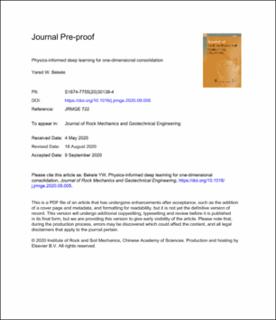| dc.contributor.author | Bekele, Yared Worku | |
| dc.date.accessioned | 2020-11-16T08:25:36Z | |
| dc.date.available | 2020-11-16T08:25:36Z | |
| dc.date.created | 2020-11-12T20:09:51Z | |
| dc.date.issued | 2020 | |
| dc.identifier.issn | 1674-7755 | |
| dc.identifier.uri | https://hdl.handle.net/11250/2687939 | |
| dc.description.abstract | Neural networks with physical governing equations as constraints have recently created a new trend in machine learning research. In this context, a review of related research is first presented and discussed. The potential offered by such physics-informed deep learning models for computations in geomechanics is demonstrated by application to one-dimensional (1D) consolidation. The governing equation for 1D problems is applied as a constraint in the deep learning model. The deep learning model relies on automatic differentiation for applying the governing equation as a constraint, based on the mathematical approximations established by the neural network. The total loss is measured as a combination of the training loss (based on analytical and model predicted solutions) and the constraint loss (a requirement to satisfy the governing equation). Two classes of problems are considered: forward and inverse problems. The forward problems demonstrate the performance of a physically constrained neural network model in predicting solutions for 1D consolidation problems. Inverse problems show prediction of the coefficient of consolidation. Terzaghi’s problem, with varying boundary conditions, is used as a numerical example and the deep learning model shows a remarkable performance in both the forward and inverse problems. While the application demonstrated here is a simple 1D consolidation problem, such a deep learning model integrated with a physical law has significant implications for use in, such as, faster real-time numerical prediction for digital twins, numerical model reproducibility and constitutive model parameter optimization. | en_US |
| dc.language.iso | eng | en_US |
| dc.rights | CC BY-NC-ND | * |
| dc.rights.uri | http://creativecommons.org/licenses/by-nc-nd/4.0/ | * |
| dc.subject | Physics-informed deep learning | en_US |
| dc.subject | Consolidation | en_US |
| dc.subject | Forward problems | en_US |
| dc.subject | Inverse problems | en_US |
| dc.title | Physics-informed deep learning for one-dimensional consolidation | en_US |
| dc.type | Peer reviewed | en_US |
| dc.type | Journal article | en_US |
| dc.description.version | submittedVersion | en_US |
| dc.rights.holder | © 2020 Institute of Rock and Soil Mechanics, Chinese Academy of Sciences | en_US |
| dc.subject.nsi | VDP::Teknologi: 500::Berg‑ og petroleumsfag: 510 | en_US |
| dc.source.journal | Journal of Rock Mechanics and Geotechnical Engineering | en_US |
| dc.identifier.doi | 10.1016/j.jrmge.2020.09.005 | |
| dc.identifier.cristin | 1847551 | |
| cristin.ispublished | true | |
| cristin.fulltext | preprint | |
| cristin.qualitycode | 1 | |

